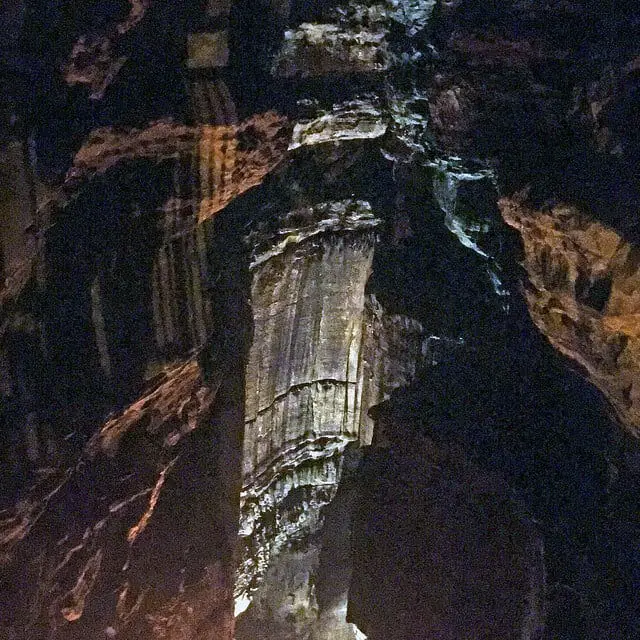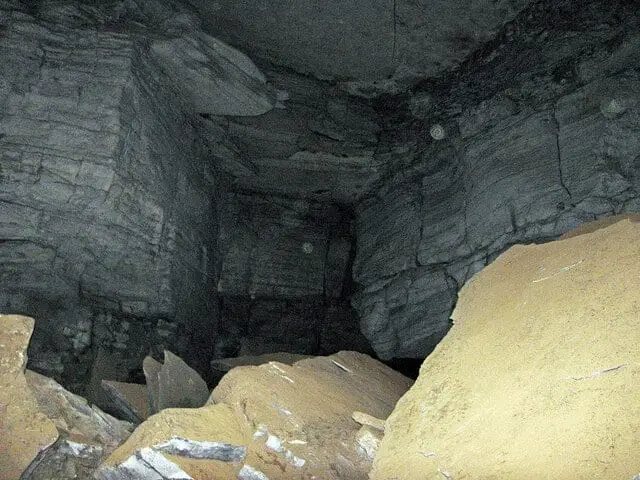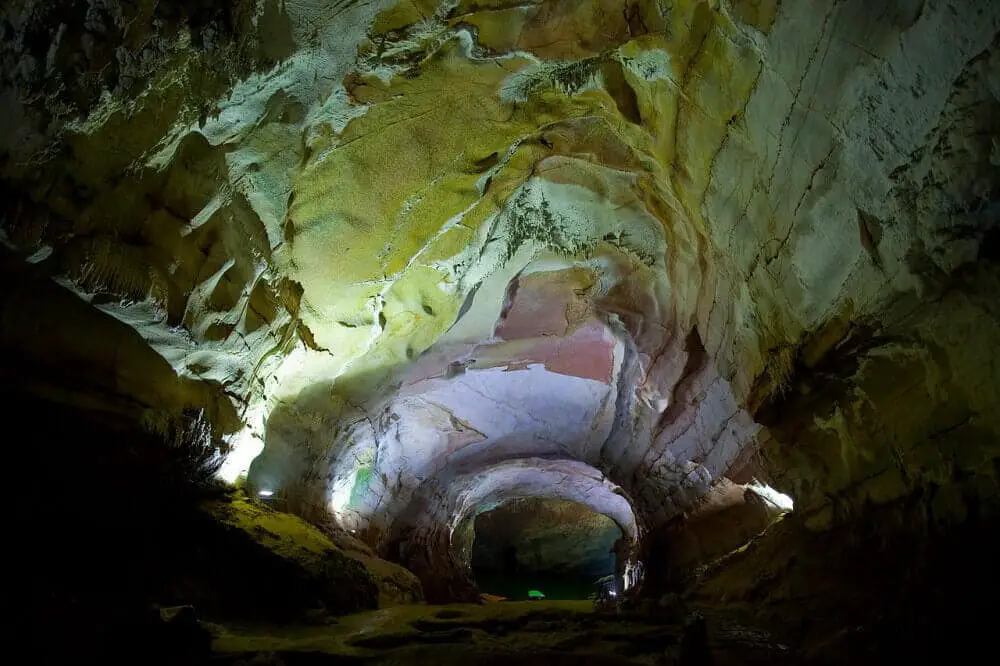Phreatic tube, rifts, drain shaft – if you’re interested in how cave passages come to shape, this article is for you. For each type of passage, I’ll briefly discuss how it’s formed and what it looks like. From now on, identify any type of cave formation using my illustrated guide below.
In this article I’ll discuss:
- The kinds of passages
- Phreatic tubes
- Vadose passages
- Epiphreatic passages
- Fault Formed passages
- Fissures or Rifts
If you want to get a quick overview of all passage types in one graph, perfect. Scroll down to get the infographic I’ve made.
Types of Cave Passages
There are basically four types of caves. Which type of cave we’re looking at is determined by how it was formed. That’s why analyzing a passage gives us all kinds of clues on how it was formed. Generally, caves take one of four ways to come about, resulting in four basic passage shapes. They’re created based on water chemistry, rock structure, and type of water flow. Also, stress fields surrounding caves attribute to the passage shape. The cave types are:
- branchwork – most common cave pattern, carved out by groundwater traveling downstream
- network – created by the chemical erosion of fissures
- sponge – created by rising water table and chemical dissolution
- anastomosing – created by solution beds, these passages are mostly horizontal

When we look at how cave passages come into being, we must determine what force of nature has shaped it. There are roughly two causes for passage formation:
- water – passages formed by water trickling down (chemical erosion) or flowing under pressure from the bottom (streams)
- faults – passages formed by the tension (and tension release) of fault lines
Water formations can be recognized by their solutional, flowing surface. Fault formations can be recognized by their angular, fractured surface.

Phreatic Passages
The phreatic zone of a cave lies below the water table. Passages that are created by flowing water under pressure are called phreatic passages. They form below the water table, and when the water level drops, a passage remains. Being mostly oval-shaped, they are also called phreatic tubes.

The visible enlargement up joints and small faults is a good indication that the passage is phreatic. It’s likely that water has ran through this cavity under pressure once, smashing into the joints and penetrating any fissures, carving out a smooth and flowing phreatic tube.

Avens or bell holes
Avens are vertical tubes in the ceiling of the cave. They are formed by water swirling around under extreme pressure, trying to find its way out from the bottom. Some avens are so deep they can look like shafts. Because of the way they develop, it’s safe to assume avens are generally a dead end.

Soluble bed
These passages are formed when a layer carbonarite rock (soluble) is emerged in water, and the water dissolves the rock. After the water table drops, a soluble bed remains. Soluble beds are generally very wide and low. The ceiling and floor are smooth.

Vadose Passages
The vadose zone of a cave lies above the water table. Vadose passages are formed by free-flowing water, which creates channels. They include shafts and canyons, carved out by streams very similar to those on the surface.
As water levels drop in a phreatic tube, only a small stream at the bottom remains. The stream starts carving out a smaller passage in the bottom, which slowly digs deeper. These are also called stream passages. The shape of the incision tells us a lot about the way it has been formed:
- Narrow incisions suggest rapid incision: fast vadose passages are narrow.
- Wide areas on the other hand suggest stable water levels: slow vadose passages are wide.
The complete vadose system of a cave is also called the drain complex.

Keyhole passage
A classic key-hole shaped passage is carved out by the stream. This is called the keyhole or vadose passage. Some keyhole passages are too narrow to travel across. That’s where your caving skills come in: you can make progress by traversing the top (which is the bottom of the original phreatic tube).

Drain shafts
Drain shafts develop by water trickling down along break lines and fractures. They carve out a vertical shaft that can connect horizontal passages on different levels. They are almost always vertical, straight, and narrow; although they can get very large over time.

Breakout chambers or domes
These passages are formed by the collapse of the ceiling of a phreatic tube. They can be recognized by breakdown on the floor and sometimes a vault-like shape at the top.

Epiphreatic Passages
The epiphreatic (floodwater) zone lies in between the vadose and phreatic zone. It is flooded during high water and drained during low water. This means it contains both types of water flow (under pressure and free-flowing).
Intertidal passages
These passages are formed by water flooding in and out of the cave. This can be the ocean’s tide or changing water levels in general.

Fault Formed Passages
Fault formed passages are formed by seismic activity. Any planar hanging walls are a indication of a possible fault. Planars are formed when there is a large displacement due to rock-mass movement. With the energy release a stretch of rock splits. The usually results in large stretches of straight rock. They are easy to spot as straight walls are unusual in a cave.


Fissure or Rift Passages
These passages are straight and narrow, and usually way deeper than wide. They start out by the cracking or splitting of rock. They develop along the joint as they wear out and widen. Also known as well or vertical shafts.
Rift passages can be both phreatic and vadose: they can develop by water forcing through under pressure, or by centuries of water trickling down, eroding the shaft slowly.

Infographic With All Passage Shapes
Based on my research I’ve designed this infographic showing all cave passage types in one graph. I’m very pleased with it. If you find it helpful, please consider sharing it – many thanks.
If you want this image in full resolution (2400 x 6300), you can download it here for free

Sources for this post
- Limestones and Caves of Wales (link to Google Books), by Trevor D. Ford and the BCA
- Effects of Stress on Cave Passage Shape in Karst Terranes (link to ResearchGate), by E. M. Criss, R. E. Criss, and G. R. Osburn
- Hypogene Karst of Texas (link to download PDF), by Douglas Kirkland
- The pattern of caves: controls of epigenic speleogenesis (link to research), by Philippe Audra et Arthur N. Palmer
- This great resource on drawing cave maps (link to pdf) by Hinko
- Cave – Wikipedia
Photos courtesy of
Dave Bunnell – CC BY-SA 2.5
James St. John – CC BY 2.0
James St. John – CC BY 2.0
Ingo Mehling – CC BY-SA 3.0
James St. John – CC BY 2.0
Shansov – CC BY-SA 3.0
Adventure Jay
Fulvio Spada – CC BY-SA 3.0

